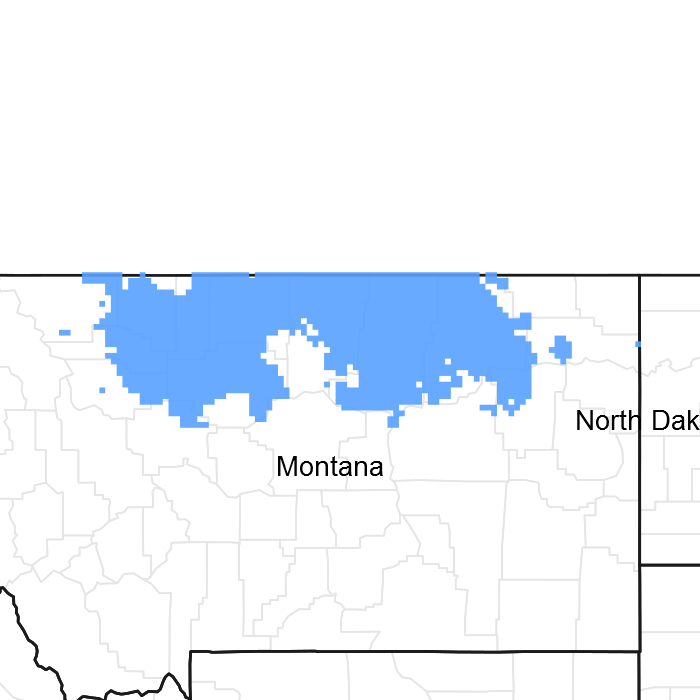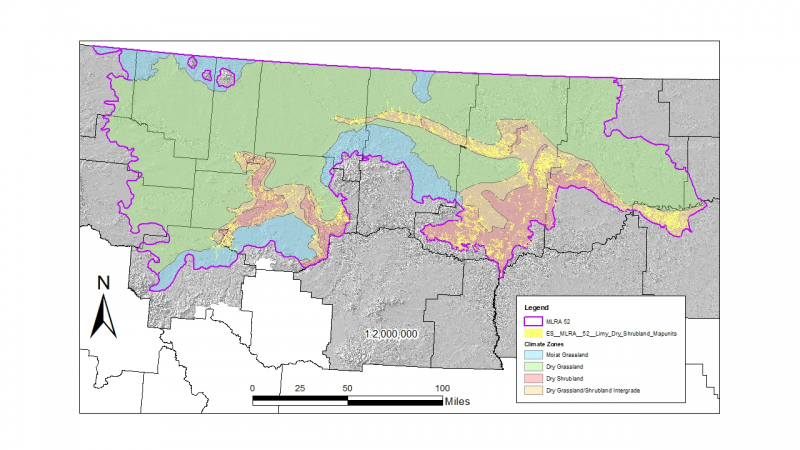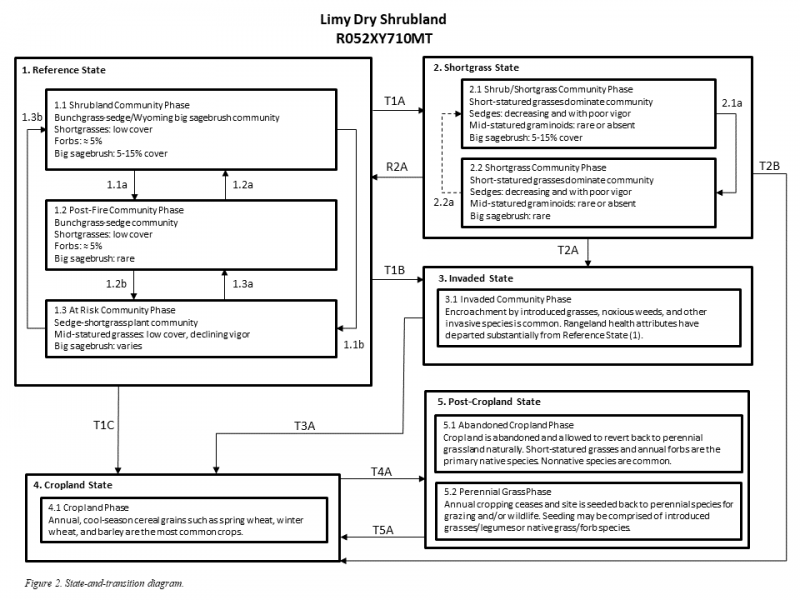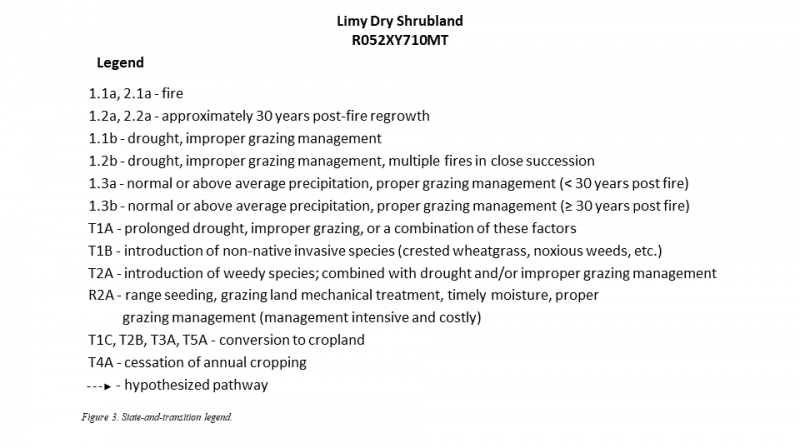Ecological dynamics
The information in this ecological site description, including the state-and-transition model (STM), was developed based on historical data, current field data, professional experience, and a review of the scientific literature. As a result, all possible scenarios or plant species may not be included. Key indicator plant species, disturbances, and ecological processes are described to inform land management decisions.
The Limy Dry Shrubland provisional ecological site in MLRA 52 consists of five states: The Reference State (1), the Shortgrass State (2), the Invaded State (3), the Cropland State (4), and the Post-Cropland State (5). Plant communities associated with the Limy Dry Shrubland ecological site evolved under the combined influences of climate, grazing, and fire. Extreme climatic variability results in frequent droughts, which can have the greatest influence on the relative contribution of species cover and production (Coupland, 1958, 1961; Biondini et al., 1998). Due to the dominance of cool-season graminoids, annual production is highly dependent upon mid- to late-spring precipitation (Heitschmidt and Vermeire, 2005; Anderson, 2006).
Native grazers also shaped these plant communities. American bison (Bison bison) were the dominant historic grazer, but pronghorn (Antilocapra americana), elk (Cervus canadensis), and deer (Odocoileus spp.) were also common. Small mammals such as prairie dogs (Cynomys spp.) and ground squirrels (Urocitellus spp.) also influenced this plant community (Salo et al., 2004). Grasshoppers and periodic outbreaks of Rocky Mountain locusts (Melanoplus spretus) also played an important role in the ecology of these communities (Lockwood, 2004).
Fire is a critical dynamic on the Limy Dry Shrubland ecological site. The historic ecosystem experienced relatively frequent lightning-caused fires. Historically, Native Americans also set frequent fires. The majority of lightning-caused fires occurred in July and August; whereas, Native Americans typically set fires during spring and fall to correspond with the movement of bison (Higgins, 1986). It is difficult to precisely determine the fire return interval in the Dry Shrubland climate zone, but estimates range from 6 to 25 years (Bragg, 1995) to 10 to 70 years (Howard, 1999).
Generally, the herbaceous vegetation is resilient to fire and the primary effects of fire are reduction of litter and short term fluctuations in production (Vermeire et al., 2011, 2014). However, studies have shown that very short fire return intervals (less than 5 years) can have a negative effect, shifting species composition toward warm-season, short-statured grasses (Shay et al., 2001; Smith and McDermid, 2014). Conversely, fire has a significant effect on Wyoming big sagebrush cover. Wyoming big sagebrush is a non-sprouting shrub and is most often killed by fire (Howard, 1999). Often, it may take 30 years or more for a stand to recover following fire (Watts and Wambolt, 1996; Wambolt et. al., 2001). It is likely that fire return intervals shorter than 30 years will result in a reduction in Wyoming big sagebrush cover over the long term. Long-term fire suppression in the 20th century removed periodic fire from the ecosystem altogether. Very little is known how this has affected the Dry Shrubland ecosystem. Some studies suggest an increase in Wyoming big sagebrush cover, presumably due to fire suppression (Bloom-Cornelius, 2011). Increased decadence in Wyoming big sagebrush may also occur (Howard, 1999), but these results are inconclusive.
Lack of periodic fires can also result in an increase in litter accumulation and, in some cases, provide ideal conditions for seed germination and seedling establishment of non-native annual brome species, such as field or Japanese brome (Bromus arvensis) (Whisenant, 1990). These species have become naturalized in relatively undisturbed grasslands (Ogle et al., 2003; Harmoney, 2007) and can be present in any state within the scope of this ecological site. They typically do not have a significant ecological impact; however, their presence can reduce the production of cool-season perennial grasses in some cases (Haferkamp et al., 1997). Their abundance varies depending on precipitation and germination conditions. The fire-recovery cycle is a critical element in managing the Dry Shrubland ecosystem. Further study is needed in this area to determine a balanced and sustainable fire cycle.
Improper grazing of this site can result in a reduction in the cover of the cool-season midgrasses and eventually a decrease in other cool-season graminoids and an increase in blue grama (Smoliak et al., 1972; Smoliak, 1974). Improper grazing practices include any practices that do not allow sufficient opportunity for plants to physiologically recover from a grazing event or multiple grazing events within a given year, and that do not provide adequate cover to prevent soil erosion over time. These practices may include, but are not limited to, overstocking, continuous grazing, and inadequate seasonal rotation moves over multiple years. Periods of extended drought can reduce mid-statured, cool-season grasses and shift the species composition of this community to one dominated by blue grama (Coupland, 1958, 1961). Further degradation of the site due to improper grazing can result in a community dominated by shortgrasses such as blue grama and Sandberg bluegrass. Cover of mid-statured grasses is severely reduced or absent. Cover of prairie sagewort can increase.
Due to the increased concentration of calcium carbonate near the soil surface and the weakly developed soil profile, this ecological site is not generally regarded as productive cropland. Regardless, many acres have been cultivated and planted to crops. The most common crops are cereal grain crops, such as winter wheat, spring wheat, and barley. When taken out of production, the site is either allowed to revert back to perennial grassland or is seeded with introduced species. Seeding of introduced grasses, particularly crested wheatgrass (Agropyron cristatum), was a common practice on eroded and abandoned agricultural areas after the droughts of the 1930s (Rogler and Lorenz, 1983). Crested wheatgrass is a highly drought tolerant and competitive cool-season, perennial bunchgrass (Lesica and DeLuca, 1996). Crested wheatgrass can invade relatively undisturbed grasslands, reducing cover and production of native cool-season midgrasses (Heidinga and Wilson, 2002; Henderson and Naeth, 2005). Sites left to undergo natural plant succession after cultivation can, over several decades, support native vegetation similar to the Reference State (1) (Christian and Wilson, 1999), although it may take over 75 years for soil organic matter to return to its pre-disturbed state (Dormaar and Willms, 1990). However, those sites seeded with non-native species, particularly crested wheatgrass, may persist with this cover type indefinitely (Christian and Wilson, 1999).
The state-and-transition model (STM) diagram (Figure 2) suggests possible pathways that plant communities on this site may follow as a result of a given set of ecological processes and management. The site may also support states not displayed in the STM diagram. Landowners and land managers should seek guidance from local professionals before prescribing a particular management or treatment scenario. Plant community responses vary across this MLRA due to variability in weather, soils, and aspect. The reference community phase may not necessarily be the management goal. The lists of plant species and species composition values are provisional and are not intended to cover the full range of conditions, species, and responses for the site. Species composition by dry weight is provided when available and is considered provisional based on the sources identified in the narratives associated with each community phase.
State 1: Reference State
The Reference State (1) contains three community phases characterized by mid-statured cool-season bunchgrasses, sedge, and Wyoming big sagebrush, a perennial, evergreen, non-sprouting shrub. Lesser spikemoss, also known as dense clubmoss (Selaginella densa), is typically absent on this site. This state evolved under the combined influences of climate, grazing, and fire with climatic variation having the greatest influence on cover and production. In general, this state was resilient to grazing, although heavy grazing could influence species composition in localized areas.
Phase 1.1: Shrubland Community Phase
The Shrubland Community Phase (1.1) is dominated by needle and thread, threadleaf sedge, and Wyoming big sagebrush. Needle and thread is the only mid-statured bunchgrass common on this site. Rhizomatous wheatgrass species such as western wheatgrass (Pascopyrum smithii) and thickspike wheatgrass (Elymus lanceolatus) are not as prevalent as on associated sites, and their composition by weight is generally 5 percent or less. Short-statured grasses, such as blue grama (Bouteloua gracilis), prairie Junegrass (Koeleria macrantha), and Sandberg bluegrass (Poa secunda), are common although cover and production are low. Plains muhly (Muhlenbergia cuspidata) may also be common on this site in some instances. Common forbs are scarlet globemallow (Sphaeralcea coccinea) and spiny or Hood’s phlox (Phlox hoodii). The principle shrub on this site is Wyoming big sagebrush, canopy cover is typically 5 to 15 percent. Subshrubs include prairie sagewort (Artemisia frigida), winterfat (Krascheninnikovia lanata), and, occasionally, soapweed yucca (Yucca glauca). The approximate species composition of the reference plant community is as follows:
Percent composition by weight*
Needle and thread 30%
Threadleaf sedge 30%
Blue grama 5%
Other native grasses 10%
Perennial forbs 5%
Wyoming big sagebrush 15% (canopy cover 5-15%)
Other shrubs/subshrubs 5%
Estimated Total Annual Production (lbs./ac)*
Low - 400
Representative Value - 600
High - 800
Average Shrub Height (inches)*
Low - 3
Representative Value - 7
High - 12
*Estimated based on current data – subject to revision
Phase 1.2: Post-Fire Community Phase
The Post-Fire Community Phase (1.2) occurs when the plant community is burned either by wildfire or prescribed fire and may persist for as long as 30 years after burning. It is characterized by a needle and thread and threadleaf sedge plant community. The rhizomatous wheatgrasses are present, although not prevalent, and composition is generally 5 percent or less. Short-statured, grasses, such as blue grama, prairie Junegrass, and Sandberg bluegrass are common. Plains muhly may also be common on this site in some instances. Total cover of shortgrasses is similar to Shrubland Community Phase (1.1). Wyoming big sagebrush will be eliminated or nearly so immediately following fire. Recovery of Wyoming big sagebrush depends on many factors including climate, proximity to a seed source, and fire intensity. Typically, there is little or no regeneration for 5 to 10 years post-fire, then cover begins to increase gradually until an equilibrium level is reached (Watts and Wambolt, 1996). Generally recovery is prolonged, sometimes taking as long as 30 years (Wambolt et al., 2001).
Phase 1.3: At Risk Community Phase
The At Risk Community Phase (1.3) occurs when site condition declines due to drought or improper grazing management. Multiple fires in close succession can also transition the site to this phase. This community phase is characterized by a threadleaf sedge-shortgrass plant community. Shortgrasses, particularly the warm-season, mat-forming blue grama, are increasing in this phase. Mid-statured grasses such as needle and thread are declining in cover and vigor. Prairie Junegrass, Sandberg bluegrass, and the subshrub, prairie sagewort, also increase in this phase. Cover of Wyoming big sagebrush will vary depending on the length of time since the last burn.
Community Phase Pathway 1.1a
Fire will transition the Shrubland Community Phase (1.1) to the Post-Fire Community Phase (1.2). Wyoming big sagebrush is killed and perennial grasses will dominate the site.
Community Phase Pathway 1.1b
Drought, improper grazing management, or a combination of these factors can shift the Shrubland Community Phase (1.1) to the At Risk Community Phase (1.3). These factors favor an increase in blue grama and a decrease in cool-season midgrasses (Coupland, 1961; Shay et al., 2001). Wyoming big sagebrush cover will be similar to the Shrubland Community Phase (1.1).
Community Phase Pathway 1.2a
Thirty years or more of natural vegetative regrowth will transition the Post-Fire Community Phase (1.2) to the Shrubland Community phase (1.1). Thirty years or more without fire permits Wyoming big sagebrush to recolonize the site.
Community Phase Pathway 1.2b
Drought, improper grazing management, multiple fires in close succession, or a combination of these factors can shift the Post-Fire Community Phase (1.2) to the At Risk Community Phase (1.3). These factors favor an increase in blue grama and a decrease in cool-season midgrasses (Coupland, 1961; Shay et al., 2001). Wyoming big sagebrush cover will be similar to the Post-Fire Community Phase (1.2).
Community Phase Pathway 1.3a
Less than 30 years post-fire; normal or above-average precipitation and proper grazing management transitions the At Risk Community Phase (1.3) to the Post-Fire Community Phase (1.2).
Community Phase Pathway 1.3b
Thirty years or more post-fire; normal or above-average precipitation and proper grazing management transitions the At Risk Community Phase (1.3) to the Shrubland Community Phase (1.1).
Transition T1A
Prolonged drought, improper grazing practices, or a combination of these factors weaken the resilience of the Reference State (1) and drive its transition to the Shortgrass State (2). The Reference State (1) transitions to the Shortgrass State (2) when mid-statured graminoids become rare and contribute little to production. Shortgrasses such as blue grama, Sandberg bluegrass, and prairie Junegrass dominate the plant community. Threadleaf sedge cover is reduced, and vigor is low.
Transition T1B
The Reference State (1) transitions to the Invaded State (3) when aggressive perennial grasses or noxious weeds invade the Shortgrass State (2). Crested wheatgrass, in particular, is a concern when native plant communities are adjacent to seeded pastures. Exotic plant species dominate the site in terms of cover and production. Site resilience has been substantially reduced. In addition, other rangeland health attributes, such as reproductive capacity of native grasses (Henderson and Naeth, 2005) and soil quality (Smoliak and Dormaar, 1985; Dormaar et al., 1995), have been substantially altered from the Reference State (1).
Transition T1C
Tillage or application of herbicide followed by seeding of cultivated crops, such as winter wheat, spring wheat, and barley, transitions the Reference State (1) to the Cropland State (4).
State 2: Shortgrass State
The Shortgrass State (2) consists of two community phases. The dynamics of this state are driven by long-term drought, improper grazing management, or a combination of these factors. Blue grama increases with long-term improper grazing at the expense of cool-season midgrasses (Coupland, 1961; Biondini and Manske, 1996; Derner and Whitman, 2009). Once established, blue grama-dominated communities can alter soil properties, creating conditions that resist establishment of other grass species (Dormaar and Willms, 1990; Dormaar et al., 1994). Reductions in stocking rates can reduce blue grama cover and increase the cover of cool-season midgrasses, although this recovery may take decades (Dormaar and Willms, 1990; Dormaar et al., 1994). Cover of Wyoming big sagebrush varies depending on fire frequency, with dynamics similar to the Reference State (1).
Phase 2.1: Shrub/Shortgrass Community Phase
The Shrub/Shortgrass Community Phase (2.1) occurs when site conditions decline due to long-term drought or improper grazing, and a fire has not occurred on the site for at least 30 years. In this phase, mid-statured grasses have been largely eliminated and replaced by short-statured species, such as blue grama, prairie Junegrass, and Sandberg bluegrass. Cover of threadleaf sedge is low, vigor is poor, and plants are often heavily grazed. Blue grama resists grazing due to its low stature and extensive root system. Prairie sagewort may also increase in this phase. Cover of Wyoming big sagebrush is 5 to 15 percent.
Phase 2.2: Shortgrass Community Phase
The Shortgrass Community Phase (2.2) occurs when site conditions decline due to long-term drought or improper grazing, and a fire has occurred on the site less than 30 years prior. In this phase, mid-statured grasses have been largely eliminated and replaced by short-statured species, such as blue grama, prairie Junegrass, and Sandberg bluegrass. Cover of threadleaf sedge is low, vigor is poor, and plants are often heavily grazed. Blue grama resists grazing due to its low stature and extensive root system. Prairie sagewort may also increase in this phase. Wyoming big sagebrush is rare.
Community Phase Pathway 2.1a
Fire will transition the Shrub/Shortgrass Community Phase (2.1) to the Shortgrass Community Phase (2.2). Wyoming big sagebrush is killed and perennial grasses will dominate the site.
Community Phase Pathway 2.2a
It is believed that 30 years or more of natural vegetative regrowth could transition the Shortgrass Community Phase (2.2) to the Shrub/Shortgrass Community Phase (2.1). It is possible that this transition could occur over time, however, the processes are not fully understood at this time. Therefore, this pathway is considered hypothetical until further investigation can be completed.
Transition T2A
The Shortgrass State (2) transitions to the Invaded State (3) when aggressive perennial grasses, noxious weeds, and other invasive plants invade the Shortgrass State (2). Exotic plant species dominate the site in terms of cover and production. Site resilience has been substantially reduced.
Transition T2B
Tillage or application of herbicide followed by seeding of cultivated crops, such as winter wheat, spring wheat, and barley, transitions the Shortgrass State (2) to the Cropland State (4).
Restoration Pathway R2A
Blue grama can resist displacement by other species (Dormaar and Willms, 1990; Laycock, 1991; Dormaar et al., 1994; Lacey et al., 1995). A reduction in livestock grazing pressure alone may not be sufficient to reduce the cover of blue grama in the Shortgrass State (3) (Dormaar and Willms, 1990) and mechanical treatments may be necessary (Hart et al., 1985). Therefore, returning the Shortgrass State (2) to the Reference State (1) can require considerable cost, energy, and time.
State 3: Invaded State
The Invaded State (3) occurs when invasive plant species invade adjacent native grassland communities. Crested wheatgrass is a common concern, especially when native plant communities are adjacent to seeded pastures. An estimated 20 million acres of crested wheatgrass have been planted in the western U.S. (Holechek, 1981). Crested wheatgrass produces abundant seeds that can dominate the seed bank of invaded grasslands (Henderson and Naeth, 2005), although crested wheatgrass cover decreases with increasing distance from seeded areas (Heidinga and Wilson, 2002). The early growth of crested wheatgrass allows this species to take advantage of early season soil moisture, which may result in competitive exclusion of native cool-season rhizomatous wheatgrasses and bunchgrasses, such as needle and thread and prairie Junegrass (Christian and Wilson, 1999; Heidinga and Wilson, 2002; Henderson and Naeth, 2005). Reduced soil quality (Dormaar et al., 1995), reduced plant species diversity, and simplified structural complexity (Henderson and Naeth, 2005) result in a state that is substantially departed from the Reference State (1).
Other invasive species that could be a concern are annual bromes and noxious weeds. Annual bromes are generally not a significant concern in MLRA 52, however, in the Dry Shrubland, there could be instances where they do significantly affect the site. More information is needed to assess this condition. Noxious weeds such as leafy spurge are uncommon on this site, but they may also invade and displace native species. Although very aggressive, these species can sometimes be suppressed through intensive management (herbicide application, biological control, or intensive grazing management). Control efforts are unlikely to eliminate noxious weeds, but their density can be sufficiently suppressed so that species composition, structural complexity, and soil quality are similar to that of the Reference State (1). However, cessation of control methods will most likely result in recolonization of the site by the noxious species.
Transition T3A
The Invaded State (3) will transition to the Cropland State (4) when the site is placed under cultivation.
State 4: Cropland State
The Cropland State (4) occurs when land is put into cultivation. Major crops in MLRA 52 include winter wheat, spring wheat, and barley.
Transition T4A
The transition from the Cropland State (4) to the Post-Cropland State (5) occurs with the cessation of cultivation. The site may also be seeded to perennial forage species, such as crested wheatgrass and alfalfa, or a mix of native species.
State 5: Post-Cropland State
The Post-Cropland State (5) occurs when cultivated cropland is abandoned and allowed to either re-vegetate naturally or is seeded back to perennial species for grazing or wildlife use. This state can transition back to the Cropland State (4) if the site is put back into cultivation. No formal studies have been obtained regarding big sagebrush recovery following cultivation. Preliminary evidence suggests that, initially, silver sagebrush may replace big sagebrush in this state. Further investigation is needed to assess big sagebrush recovery in the Post-Cropland State (5).
Phase 5.1: Abandoned Cropland Phase
The Abandoned Cropland Phase (5.1) occurs in when cropland is abandoned In the absence of active management, the site can re-vegetate naturally and, over time, potentially return to a perennial grassland community with needle and thread and blue grama. Shortly after cropland is abandoned, annual and biennial forbs and annual brome grasses invade the site (Samuel and Hart, 1994). The site is highly susceptible to erosion due to the absence of perennial species. Eventually, these pioneering annual species are replaced by perennial forbs and perennial shortgrasses, such as Sandberg bluegrass and blue grama. Depending on the historical management of the site, perennial bunchgrasses such as needle and thread may also return; however, species composition will depend upon the seed bank. Cover and production of cool-season rhizomatous wheatgrasses is low, even after several decades (Dormaar and Smoliak, 1985; Dormaar et al., 1994; Christian and Wilson, 1999). Invasion of the site by exotic species, such as crested wheatgrass, and annual bromes will depend upon the site’s proximity to a seed source.
Fifty or more years after cultivation, these sites may have species composition similar to phases in the Reference State (1). However, soil quality is consistently lower than conditions prior to cultivation (Dormaar and Smoliak, 1985; Christian and Wilson, 1999) and a shift to the Reference State (1) is unlikely within a reasonable timeframe.
Phase 5.2: Perennial Grass Phase
The Perennial Grass Phase (5.2) occurs when the site is seeded to perennial forage species. When seeded to introduced species, particularly perennial grasses such as crested wheatgrass, this community phase can persist for several decades. Monocultures of crested wheatgrass can persist for at least 60 years (Krzic et al., 2000; Henderson and Naeth, 2005). A mixture of native species may also be seeded to provide species composition and structural complexity similar to that of the contemporary reference state (2). However, soil quality conditions have been substantially altered and will not return to pre-cultivation conditions within a reasonable timeframe (Dormaar et al., 1994).
Transition 5A
Tillage or application of herbicide followed by seeding of cultivated crops, such as winter wheat, spring wheat, and barley, transitions the Post-Cropland State (5) to the Cropland State (4).




